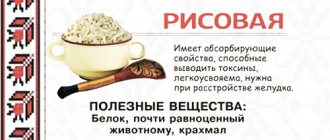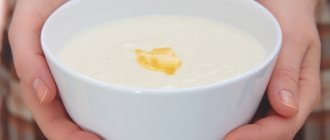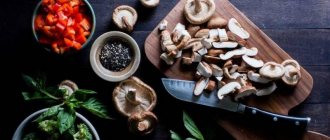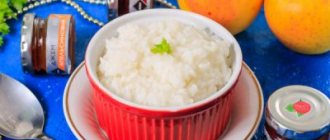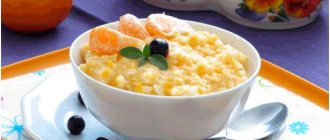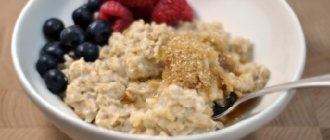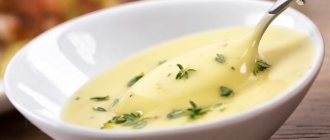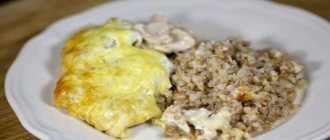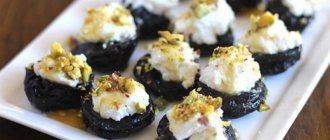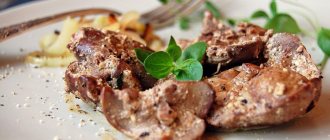Rice porridge - benefits and harms, cooking rules
The nutritional value and taste characteristics of dishes made from rice are highly valued in many countries around the world. The benefits and harms of rice porridge deserve special attention. It can be a side dish and dessert; it is allowed to use water, broth and milk to boil the cereal. Depending on the characteristics of the approach, the dietary and medicinal properties of the product appear. There are very few restrictions on the inclusion of rice porridge in the diet, of course, provided that it is made taking into account the specifics of the main ingredient.
Features of preparing rice porridge
A diet based on the consumption of rice porridge can ensure longevity, prolong youth and beauty, and protect against excess weight problems. True, all this is possible only if you observe the peculiarities of preparing the dish and take a responsible attitude to the choice of the main component. Here are a few things to keep in mind when introducing nutrient composition into your diet:
- Despite the fact that rice porridge with milk is especially popular among consumers, the benefits of such a composition are questionable. A drink brought to a boil loses a lot of important substances, some of its elements change shape. As a result of such reactions, the finished dish is not so well absorbed by the body. An additional disadvantage of this option is its increased caloric content and nutritional value.
- Many families traditionally use polished cereal to boil rice porridge. It boils well and quickly, which is why the finished mass turns out tender and airy. But it has few therapeutic properties. The product can be an excellent source of energy, but nothing more.
Tip: Many housewives rinse and even soak the rice several times before preparing rice porridge. This technique only deprives the preparation of a number of useful ingredients. It is better to initially purchase a high-quality product that is enough to be sorted and can be immediately processed.
- Few people use wild, red or brown rice as the base of the dish. Namely, they make the most healthy rice porridge. Its texture will be peculiar, but quite pleasant.
If you follow the cooking technology, tasty and healthy rice porridge can be obtained even from steamed rice. There is no need to look for a suitable recipe for each type and variety of cereal. The approach is the same in all cases, only the result in each case has its own specifics.
Composition and beneficial properties of rice porridge
Depending on the list of ingredients used, the benefits and harms of rice porridge may vary. Whatever the composition, the finished dish will contain a lot of starch, amino acids, proteins, disaccharides, vitamins and minerals. But there is no gluten in rice, so porridges prepared from it rarely cause allergies.
If you take steamed or unpolished rice of simple and elite varieties as a basis, you can count on the following results:
- The optimal ratio of potassium and sodium allows you to maintain the water-salt balance at the desired level. The presence of rice porridge in the diet eliminates edema and other manifestations of fluid retention in the body.
- The fibers of the product act as an absorbent. They absorb toxins and waste as they pass through the digestive tract. This helps cleanse the body and leads to weight loss.
- The absence of salt in the composition of the cereal against the background of the presence of potassium and selenium ensures the removal of deposited salts from the tissues. It is very useful for people suffering from damage to the cardiovascular system and kidneys.
- The viscous and soft composition envelops the mucous membrane of the esophagus and stomach, protecting it from mechanical and chemical stress. This reduces the symptoms of gastritis and peptic ulcers.
- Rice porridge, even when it is non-dairy, is a source of minerals needed to maintain the texture of bones, muscles and ligaments. This is very important in childhood and old age, during the period after menopause in women.
- The presence of a nutritious dish in the diet has a positive effect on the condition of the skin, hair and nails. This is an affordable and effective cosmetic product.
Rice porridge cooked with chicken broth is more fatty. A vegetable broth product may contain additional vitamins and essential oils. But even in these cases, the basic characteristics of the product will not change.
Rules for preparing rice porridge
It is very easy to prepare delicious and healthy rice porridge. The creators of the Polzateevo portal offer a universal method of boiling cereal and point out common mistakes of housewives:
- The list of manipulations should be minimal. Do not pre-fry the cereal or dry it in the oven. It is forbidden to stir the mixture during cooking. All additional ingredients are introduced only after the dish is ready.
- For 200 ml of rice (glass), take 300 ml of water or broth. You will have to take 50 ml more milk.
- The cereal is poured into the liquid that has already been brought to a boil. If you spend time warming up the total mass, all indicators will shift and the result will not be the same.
- To prepare rice porridge, you need to choose a pan with a tight-fitting lid without a hole for steam to escape.
- The cooking time after placing the rice in the boiling base is exactly 12 minutes. The cereal only needs to be stirred once and covered with a lid. The heat should be high for 3 minutes, moderate for 7, and very low for 2.
- Remove the finished porridge from the stove without lifting the lid. We wait exactly 12 minutes and only after that add salt and butter to the dish to taste and serve.
You can add a pinch of cinnamon or vanilla sugar to the finished dish. Some people prefer rice porridge with spices and aromatic herbs. The main thing is to remember the neutral taste of the main ingredient and not overuse flavorings.
Rice porridge as a way to lose weight
Cereal boiled in water using the above method allows you to get a dish with a calorie content of 285 kcal per 100 g of product. The indicator is significant, but despite this, such rice porridge is not only safe for the figure, it promotes weight loss.
It works this way:
- The carbohydrates in the product are complex, take a long time to digest and do not cause spikes in blood glucose. They accumulate in the muscles and become a source of energy, rather than being stored as fat deposits.
- The fact that rice porridge absorbs harmful substances and promotes their removal from the body leads to the cleansing of tissues from toxins. It is the presence of these substances in the human body that often causes excess weight gain.
- The rich chemical composition of the cereal prevents the development of a stressful situation. The body does not experience a deficiency of vitamins and minerals, which does not lead to attacks of hunger or mood swings, which many try to “eat up” with sweets.
You can count on the maximum effect both when using a mono-diet based on rice porridge, and when carrying out regular fasting days. The main thing is to monitor your well-being and note the dynamics of the process.
Possible harm of rice porridge
Eating a dessert or side dish prepared using the right rice has no contraindications and cannot harm the body. If you regularly eat a dish based on cereal that has gone through several degrees of purification, the results will be as follows:
- Blood pressure will increase.
- Diabetes will worsen or develop.
- The risk of developing atherosclerosis will increase.
- Kidney stones may form.
- The functioning of the heart and blood vessels deteriorates.
You should not eat rice porridge only for the purpose of obtaining the stated benefits. The product should bring pleasure and satiate, fill the body with energy. It is enough to choose your favorite additional ingredients to turn a rather bland dish into a real delicacy.
Benefits of Brown Rice
- Fights Alzheimer's disease. Brown rice contains many components necessary for the synthesis of neurotransmitters. With a lack of these substances, Alzheimer's disease is highly likely to develop. All varieties of brown rice contain stimulators of neuroprotective enzymes that protect the brain from lipid peroxidation and its products.
- High concentration of selenium. Selenium reduces the risk of cancer, cardiovascular disease and arthritis.
- Contains a lot of manganese. One serving of brown rice contains 80% of the recommended daily intake of manganese. This element is necessary to maintain fat metabolism, optimal functioning of the nervous and reproductive systems.
- Promotes weight loss. The large amount of fiber in the grain shell not only cleanses the intestines, but also prevents spikes in sugar and insulin in the blood. Maintaining stable glucose levels speeds up the fat burning process.
- Snack for a child. White puffed rice is very tasty, and brown puffed rice is also healthy. Offer some popped brown rice to your baby, he'll love it!
- Vitamin complex. Rice contains a high concentration of vitamins PP, D, B1, B2, B6, and a lot of calcium and iron. All these substances are necessary for the normal functioning of the immune system, good metabolism, and the functioning of all organs.
Nutritional value of 100 g of brown rice
| Component | Value (weight or % of recommended daily dose) |
| Calorie content | 110 |
| Fats | 0.89 g |
| Cholesterol | 0 mg |
| Sodium | 301 mg |
| Cellulose | 1.8 g (1%) |
| Potassium | 43 mg (1%) |
| Carbohydrates | 23 g (9%) |
| Protein | 2.56 g (5%) |
| Calcium | 1% |
| Iron | 2% |
| Vitamin B6 | 5% |
| Magnesium | 3% |
How to cook porridge from brown rice?
- rinse a portion of rice;
- pour the cereal into a saucepan and add water or broth in a ratio of 1:4-5 (according to instructions);
- salt and add spices to taste;
- The cooking time for rice is determined by its variety.
RICE porridge: beneficial properties and contraindications. | HEALTHY LIFESTYLE
Rice porridge is one of the most popular and favorite porridges in our country, which is familiar to us from early childhood.
There are many recipes for making rice porridge; it can be cooked in water or milk, and various berries, vegetables, fruits and other ingredients can be added to it. But rice porridge is not only tasty, but also a very healthy dish. Composition of rice porridge: Rice porridge contains proteins (7-8%), while it is completely free of gluten (a group of proteins present in many cereals), which causes allergic reactions in many people. Rice porridge contains essential amino acids for humans. Rice porridge is rich in complex carbohydrates (about 80%), contains vitamins E and group B (B1, B2, B3, B6, B9), calcium, phosphorus, potassium, magnesium, iron, zinc and other substances necessary for human health.
Calorie content of rice porridge: The calorie content of rice porridge cooked in water is about 100 kcal per 100 grams of product. When milk, sugar, butter, fruits and other ingredients are added to rice porridge, its calorie content increases.
Useful properties of rice porridge:
- Complex carbohydrates, which rice porridge is rich in, provide the body with energy for a long time.
- Rice porridge helps strengthen the cardiovascular system.
- Positively affects the nervous system, improves sleep quality.
- Eating rice porridge has a beneficial effect on the functioning of the digestive system, helps cope with diarrhea, and is indicated for diseases of the gastrointestinal tract (gastritis, ulcers, etc.) with high acidity.
- Rice porridge has a cleansing effect and helps remove toxins and waste from the body.
- Nutritionists recommend including rice porridge in the diet of overweight people. It is low in calories and rich in nutrients.
- Experts also advise people who have suffered serious illnesses to consume rice porridge.
- Regular consumption of rice porridge has a good effect on the condition of the skin, nails and hair.
Contraindications for rice porridge: Rice porridge is contraindicated in case of individual intolerance. In addition, rice porridge should be eaten in moderation, since if consumed excessively, it can negatively affect the body of even a completely healthy person.
Eat rice porridge with pleasure and be healthy!
We advise you to read about the beneficial properties and contraindications of other cereals:
The most useful flour at pp. The healthiest flour is other types
Flour itself is high in calories, so people with diabetes or overweight are advised to consume a strictly limited amount of it per week.
The best option is considered to be up to 500 kcal per week. Useful varieties that are preferable to use instead of the classic type are buckwheat, spelled, oatmeal, rye and others.
Spelled or spelt
Spelled flour
One of the purest and lightest whole grain varieties of the product. Made from wheat germ, it is rich in healthy protein and nutritious fiber.
The proteins in its composition differ in structure, are absorbed faster and do not provoke an allergic reaction. It is suitable for diabetics, allergy sufferers and those with complete gluten intolerance.
Peeled rye or wallpaper flour
Rye flour
It is considered the roughest and most sticky and does not undergo deep processing. Rye flour contains whole parts of the grains along with the shells.
Therefore, this variety is considered more beneficial for the body, it is digested and absorbed faster without complications, does not inhibit metabolism, and helps cleanse the body.
The content of minerals and trace elements in it is increased. A suitable option for baking homemade rye bread.
Coarse wheat wallpaper
This variety is different from the usual white flour; it is obtained from purified, natural whole wheat grains.
Note! There are 3 factories on the territory of the Russian Federation that produce flour of this type: the Solnechny agricultural complex, Belovodye and Diamant. When making a purchase, make sure that there is a special eco-test sign on the packaging
This cooking method retains all the valuable vitamins and minerals found in regular flour, but at the same time reduces the gluten and starch content. Suitable for homemade lean and sweet baking.
Buckwheat flour
Buckwheat flour
A dietary option for those who cannot do without baked goods. Made from buckwheat grain. Unlike other varieties, it contains the lowest percentage of starch and a fairly high content of vitamins.
Suitable for baking muffins, buns, pancakes and sweet pastries.
Oat flour
Oat flour
It has a pleasant taste and contains many nutrients. Thanks to its excellent taste and combination with other ingredients, it can easily replace the usual white flour.
Suitable for baking muffins, sweets, pancakes and many dietary dishes.
Corn flour
Corn flour
A natural source of protein, grains and valuable dietary fiber.
It saturates the body and has a beneficial effect on weight loss, allows you to cleanse the body of toxins, remove excess water, and speed up metabolism.
It does not contain gluten, so it is suitable for diabetics, allergy sufferers, overweight people and those suffering from celiac disease.
Flaxseed flour
This variety contains up to 30% fiber and is a source of healthy dietary fiber. Therefore, its use cleanses the body and stabilizes the functioning of the digestive organs and intestines.
This composition makes this variety one of the best for a healthy diet and getting rid of extra pounds.
Rice flour
It is rich in calcium, fluorine, and folic acid, so consuming rice flour will help gently cleanse the intestines and improve digestion.
Disadvantage: Excessive consumption leads to constipation. Therefore, it must be consumed in moderation.
Rice porridge for a child - benefits and harms
They began to grow rice as a cultivated plant about 6 thousand years ago. It was first mentioned in Chinese myths. Gradually it spread throughout Asia, where it is still a staple food.
Hundreds of dishes are prepared from rice in Europe - all thanks to its taste and good combination with other ingredients. In Russia it became known about 300 years ago.
Mothers, wanting to provide their child with healthy nutrition, are interested in how healthy rice porridge is for children, whether it is suitable for infants, how different types of rice differ, and what type of cereal is best to prepare for children.
Varieties of rice
Depending on the shape and color of the grains, there are about 20 varieties of rice
There are over 20 varieties of rice in the world. Rice is classified according to grain shape and color. On sale you can see white and brown rice, parboiled, round grain, medium grain and long grain.
Depending on the processing method, rice, even of the same variety, can have not only different tastes and properties, but also different cooking times. According to the processing method, white, brown and steamed rice are distinguished:
- Brown rice, according to nutritionists, is the most beneficial. But this is not a special variety - it is whole grain cereal. Brown grains retain the bran shell, which contains many valuable substances, so they are healthier than white grains. But brown rice is coarser, it needs to be cooked twice as long, and it has a shorter shelf life.
- White rice is obtained by grinding, that is, removing all the shells from the grain. It takes 10-15 minutes to cook (the longer the grains, the longer they cook). Dishes made from it are tender and tasty, but more than half of the beneficial vitamin-mineral composition and dietary fiber are lost. The loss of magnesium is especially significant, and the fiber content is reduced by 4 times.
- Parboiled rice is prepared this way: the unhulled grains are first soaked in water, and then hot steam under pressure is applied to them, and after drying, they are polished. Steamed rice is transparent, with an amber-yellow tint, durable, but most importantly, about 80% of all useful ingredients enter the grains from the shells. True, you need to cook the cereal longer (up to 25 minutes). During cooking, it becomes white, soft, and does not stick together.
The size and shape of the grains do not affect the concentration of minerals and vitamins, but the starch content in the cereal, and therefore its culinary properties, depends on them:
- Round rice is the starchiest. It boils well, the opaque grains absorb a significant amount of liquid, become sticky, acquiring a creamy consistency. This short-grain (or round) rice is best used for making creamy soup and thin porridge for babies. White round rice is perfect for making pudding, casseroles, desserts and pies.
- Medium-grain rice sticks less and absorbs the flavors of other components of dishes well. Medium-sized white rice is suitable for making risotto. And the brown variety of medium grain rice should be chosen for a diet menu (for example, for soup). It is easy to make flour for baby food from it.
- Long-grain rice moderately absorbs liquid during cooking and does not stick together or become overcooked. It turns out crumbly and somewhat dry. This variety is considered universal; rice is suitable for preparing a wide variety of dishes, from side dishes, salads and ending with the creation of culinary masterpieces, dishes of European and Oriental cuisine.
Composition and calorie content of rice
Rice contains proteins, including 8 essential amino acids, carbohydrates in the form of polysaccharides, minerals and vitamins.
The starch content can reach 75%. There is no gluten or cholesterol in rice.
The mineral composition of rice is:
Potassium and sodium are found in cereals in a ratio of 5:1. This is the optimal proportion that helps maintain acid-base balance and remove excess fluid from the body.
In addition to vitamins PP, K, E, rice contains a whole complex of vitamins B (B1, B2, B4, B5, B6, B7, B9, B12).
The calorie content of 100 g of white rice in the form of cereal is 345 kcal, and brown rice is 330 kcal. 100 g of milk porridge made from white cereal contains 97 kcal, and porridge without milk contains 78 kcal.
Benefit
If a child is not gaining weight well, rice porridge (dairy-free or prepared with breast milk) may be recommended as the first complementary food.
Rice has many beneficial properties for a growing body:
- The content of complex carbohydrates helps replenish the body's energy costs and provide muscle strength.
- Rice differs from other grains in its pronounced absorption ability: chemical compounds are absorbed and excreted from the body.
- Rice does not irritate the mucous membranes of the gastrointestinal tract; its starch-mucosal components envelop the mucous membranes and protect them from irritation.
- Hypoallergenic rice porridge is easily digested by the baby's body, so it is recommended to be used as complementary food for infants.
- Rice does not contain gluten, which is very important if infants are unable to digest the nutrients of grains due to an imperfect enzyme system.
- Rice is a source of proteins necessary for the formation of cells and tissues.
- The vitamin-mineral complex promotes the normal formation of the nervous system and mental development of the child.
- Microelements of rice ensure healthy hair, nails, skin, and bone tissue formation.
- Rice porridge will be especially useful if the child is underweight and prone to diarrhea.
The pronounced sorption and enveloping properties of rice are used in medicinal practice.
Rice porridge and rice water are used in the treatment of:
- intestinal infections;
- food poisoning;
- inflammatory processes in the digestive tract;
- with diarrhea in a baby.
Since the therapeutic effect is associated with the action of starch, white, the most starchy, rice is used to prepare a healing decoction. It is cooked without sugar and salt. The grains absorb and remove toxic substances, and the decoction has an enveloping effect on the mucous membrane, promoting its healing.
To prepare the decoction, mix 50 g of rice flour in 1 liter of water and cook for 10 minutes. The dosage of the decoction is prescribed by the doctor depending on the condition and age.
Disadvantages of Rice
- Rice is strengthening, so if a child is prone to constipation, it is excluded from the child’s diet or consumption is significantly limited.
- Rice is a hypoallergenic product, but occasionally an allergy to the fiber contained in the cereal may occur. This may manifest itself as indigestion or constipation, flatulence, and nausea.
- Phytic acid in rice cereal interferes with the absorption of magnesium, iron and calcium. Frequent consumption of rice can provoke the development of rickets and anemia in children.
- Rice grains from some manufacturers can be treated with chemicals to better preserve the grain and kill parasites. When purchasing, you should give preference to well-known manufacturers.
- Eating white rice for children with diabetes is prohibited, as the blood sugar level can rise sharply.
Brown rice porridge can be consumed by diabetics as it contains more fiber, which prevents the conversion of starch into glucose. But eating dishes even made from brown rice should not be frequent; it should be coordinated with a pediatric endocrinologist.
When and how to introduce rice into your diet
According to pediatricians and nutritionists, rice porridge can be given to a baby as complementary food.
- If the child develops correctly, there are no problems with weight (excess or deficiency), or a tendency to allergies, then complementary foods are introduced from 6 months.
- According to the rules, porridge should be introduced after fruit and vegetable purees, at the age of about 7 months. By this time, the baby is already producing enzymes, albeit in minimal quantities, to digest porridge.
If you are prone to diarrhea and excessive regurgitation, rice porridge can be administered at an earlier date, but only as prescribed by a doctor!!
Porridge for babies is prepared using water or breast milk. At the stage of introducing it into complementary foods, porridge should be cooked not from whole grains, but from rice flour.
The consistency of the porridge should be easy for a child to swallow, without lumps. At first it is prepared liquid, and then thicker, so that the baby can be fed from a spoon rather than from a bottle.
You need to prepare porridge for your baby before feeding and give it only once a day.
- The first sample of porridge is given in the morning, no more than 1 tsp.
- The body's reaction is monitored throughout the day (the nature of the stool, the condition of the skin, etc.).
- In the absence of a negative reaction in the following days, a single serving of porridge is already 2-3 tsp. and gradually increases.
- Over the course of a week, the portion is adjusted to 120-150 g.
You should not try to give your baby a full portion as quickly as possible.
After 8 months, you can prepare porridge from whole grains of rice at the rate of 2 tbsp. l. cereals per 100 ml of water:
- On low heat, the porridge must be stirred constantly.
- After the grains have swelled, you can add 50 ml of breast milk (or formula) and cook for another 10 minutes.
- Then remove from heat and leave covered for 5 minutes.
But such porridge needs to be rubbed through a strainer before giving it to the child (or crushed with a blender). A child older than one year can be taught to eat dishes made from unground cereals.
You can add fruits and butter to the porridge no earlier than 3 months after introducing rice porridge into complementary foods. At 9-10 months, you can diversify the child’s menu, prepare rice milk soup with cauliflower, porridge with pumpkin.
Children over one year old can add fresh fruit to their porridge. Apples go well with rice, but they are recommended to be added to dairy-free porridges.
If you are prone to constipation, you can cook porridge from a mixture of oat and rice cereals, taken in a 1:1 ratio. You can also get rid of constipation by preparing rice porridge with an infusion of dried apricots, prunes, fennel, or by adding chopped dried fruits to the porridge.
Pureeed rice porridge (or made from rice flour) can be mixed with cottage cheese for children who do not like to eat it. The porridge will not only “mask” the cottage cheese, but will also soften its sour taste. If it remains, then instead of sugar you can add a little glucose or fructose.
In cases where the child does not drink milk (for example, with lactase deficiency), dairy-free rice porridge is prepared, that is, only with water.
- To improve its taste, you can add vegetable or fruit puree or butter to it.
- Or you can prepare dairy-free porridge with the addition of an apple (peeled and cut into pieces).
Grind the finished porridge with a blender to a puree-like consistency.
For infants, you can buy ready-made rice porridge. It is a powder that should be diluted with boiled water or milk (formula) before use; there is no need to boil it. Dry crushed fruits are additionally added to the composition of such porridges. This porridge can be made liquid and fed to the baby from a bottle.
Older children can serve rice with fish, meat, milk, vegetables, seafood, and mushrooms. Rice porridge is best served for breakfast or as an afternoon snack.
The following additives can give rice a special taste:
- tomato paste;
- garlic and onion;
- olive oil;
- cinnamon;
- vanilla;
- cream;
- dried fruits;
- chocolate;
- jam;
- honey;
- lemons;
- apples;
- strawberry;
- oranges.
These additives can help make rice porridge a favorite dish. But they can be used taking into account age restrictions and in the absence of allergies. By adding fruit to pudding or porridge, there is no need for sugar.
How to store cereals
An older child can add his favorite vegetables, fruits or berries to his rice porridge.
Rice should not be stored for a long time.
- It is best to keep the cereal in a dark, dry, cool place in a cloth bag, which has been pre-boiled for 20 minutes in a strong saline solution (to prevent bugs from getting in).
- You can also store rice in a tin, earthenware or glass jar with a tight-fitting lid. Inside the jar you should put a lemon peel, a clove of garlic or a little salt in a gauze knot.
Recipes for children
Before preparing the dish, any rice must be rinsed well with cold water (until clear water is obtained). After this, the round rice should be poured with warm water and left for 15 minutes, then rinsed again with cold water.
After rinsing with cold water, long rice should be rinsed with boiling water, then rinsed again with cold water.
Neither sugar nor salt are added to infant porridge.
Rice flour porridge
- Take 1 tsp. powder obtained by grinding rice grains in a coffee grinder.
- Add it to 100 ml of boiling water and cook over low heat for 10 minutes, stirring constantly (so that there are no lumps).
- Add 50 ml of milk and cook for an additional 10 minutes.
The porridge is infused for 5-10 minutes under the lid, and you can feed the baby.
Porridge with pumpkin
- Peel and cut into pieces 200 g of pumpkin pulp.
- Pour it into a saucepan with 1 glass of milk or water.
- After boiling, cook over low heat for 10 minutes.
- Add prepared rice and cook covered for 15 minutes.
Such porridge will be less calorie, beautiful in color and tasty.
Rice and vegetable porridge
It can be prepared in a slow cooker:
- Finely chop all the vegetables (1 small zucchini, 3 medium tomatoes, 2 carrots and 1 onion).
- Simmer the onions and carrots for 3-5 minutes with 30 g of oil (vegetable or butter).
- Add tomatoes, zucchini and simmer for another 5 minutes.
- Add 1.5 cups of previously washed rice, add salt and stir.
- Pour boiling water over the mixture of rice and vegetables (the water level should be about 3 cm above the vegetables and cereals).
- Set the “porridge and cereals” mode and cook for 45 minutes.
Porridge can be served as a side dish for meat.
Summary for parents
Rice is good for children's bodies. Porridge made from rice grains or flour can be given to infants as complementary foods. It is nutritious, tasty and easy to digest. You can prepare this porridge for your mother yourself or buy it ready-made.
For infants, only white, round rice is used, as it is the starchiest. For older children, steamed and brown rice are healthier.
Rice can be served as a side dish, and when combined with fruit, make a dessert.
How to choose rice
During Soviet times, only two types of rice were sold in stores in the country - round white and Indian long-grain. Nowadays there is a huge selection of any cereal on sale, but you need to know how to choose rice depending on what dish you are going to cook from it. You also need to know how to choose rice for pilaf or rolls; they require one type of rice, but for milk porridge a completely different variety is needed.
It's not so easy to choose the perfect product for certain dishes, it's a whole science. Rice should be bought in transparent bags, you should visually see what is in it. Check the bags to ensure that the cereal is the same length, without yellow grains.
If there are yellow grains, it means that the rice was stored incorrectly and is already spoiled; there is no need to buy such a product. If half of the bag of beans is cloudy and the other half is transparent, then it is better not to buy such a product. If there are often cloudy grains with clear boundaries in a bag of rice, it is bad, broken rice, and it is also not edible.
Most of all, our Russians love and choose varieties approximately the same as Arborio, an Italian variety; it has round grains and cooks very quickly. Sushi, rolls, soups and risotto are usually prepared from this variety. Basmati, a long-grained variety, is the leading variety in demand throughout the world; it is used to prepare pilaf and various side dishes.
Often chosen, Jasmine is a long-grained variety that retains a clear, light color after cooking. Desserts, cereals and side dishes are prepared from it. There is also Tibetan black rice, in the old days it was considered the privilege of emperors and was inaccessible to ordinary people; side dishes and pilaf are prepared from it.
In Russia, Krasnodar rice is considered the most widespread and is supplied to stores both long-grain and round. The climate in the Krasnodar Territory is not so hot, and ears of corn can very rarely become infected with various types of pests. The variety is environmentally friendly and maximally beneficial for health.
